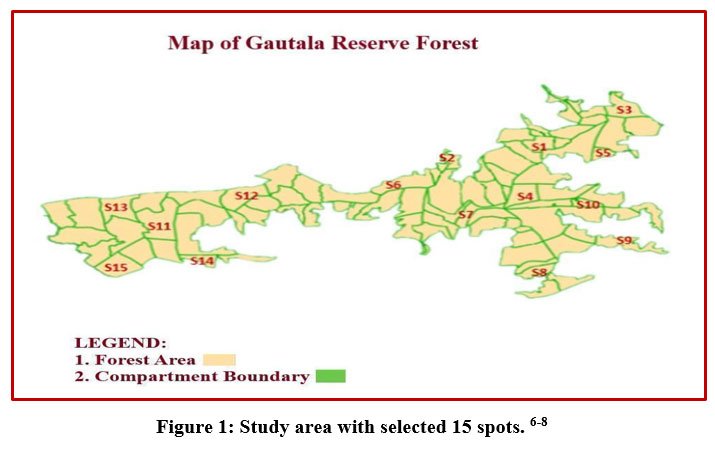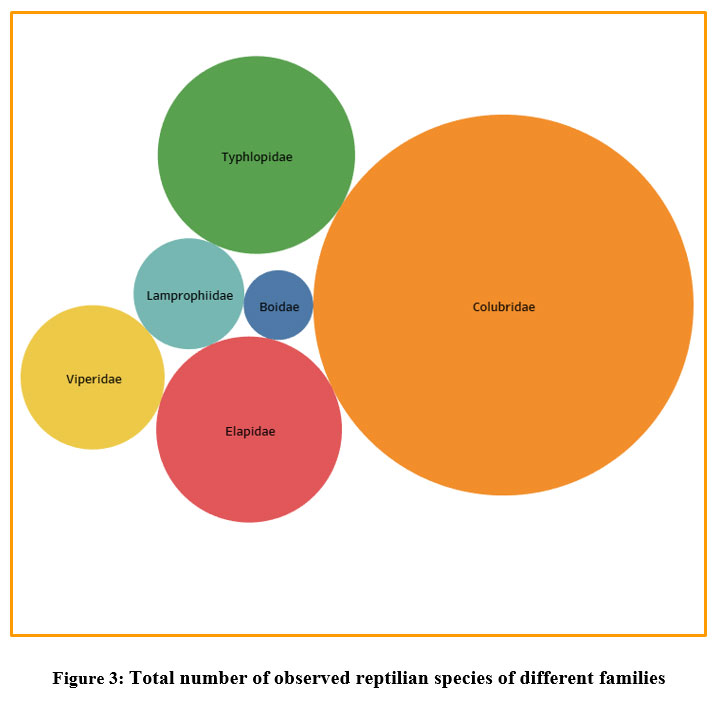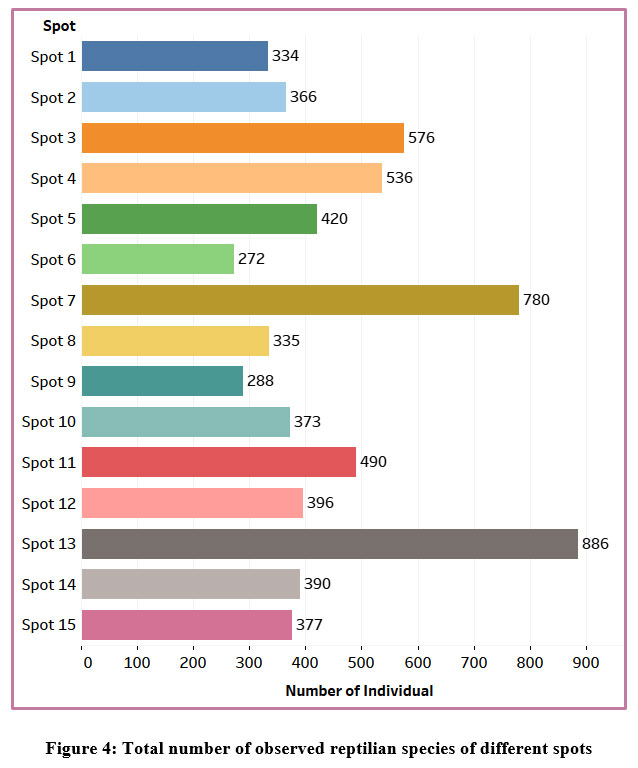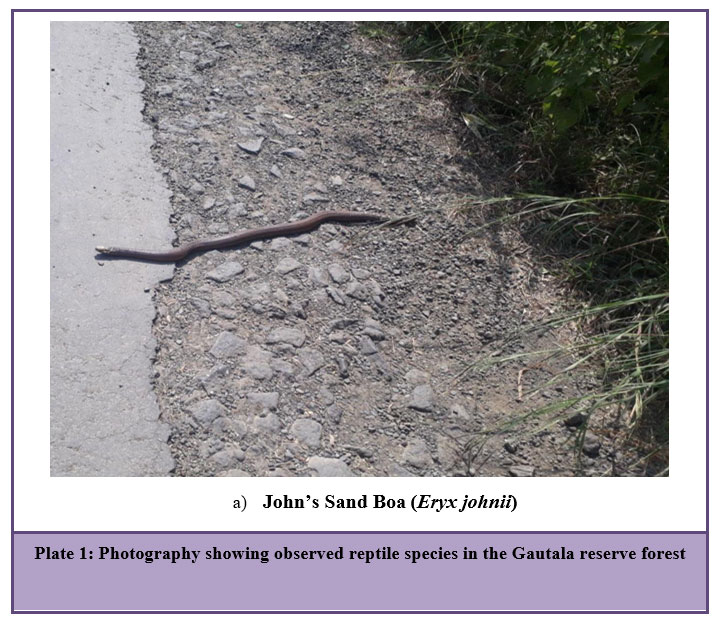Seasonal Reptilian Diversity at Gautala Reserve Forest, Aurangabad (Maharashtra), India.
1
Departement of Environmental Science,
Dr. Babasaheb Ambedkar Marathwada University,
Aurangabad,
Maharashtra
India
Corresponding author Email: amrin.42@rediffmail.com
DOI: http://dx.doi.org/10.12944/CWE.18.2.27
Copy the following to cite this article:
Mirza A. N, Patil S. S. Seasonal Reptilian Diversity at Gautala Reserve Forest, Aurangabad (Maharashtra), India. Curr World Environ 2023;18(2). DOI:http://dx.doi.org/10.12944/CWE.18.2.27
Copy the following to cite this URL:
Mirza A. N, Patil S. S. Seasonal Reptilian Diversity at Gautala Reserve Forest, Aurangabad (Maharashtra), India. Curr World Environ 2023;18(2).
Download article (pdf)
Citation Manager
Publish History
Select type of program for download
| Endnote EndNote format (Mac & Win) | |
| Reference Manager Ris format (Win only) | |
| Procite Ris format (Win only) | |
| Medlars Format | |
| RefWorks Format RefWorks format (Mac & Win) | |
| BibTex Format BibTex format (Mac & Win) |
Article Publishing History
| Received: | 2023-04-06 |
|---|---|
| Accepted: | 2023-05-29 |
| Reviewed by: | 
 Shemaa Fatih
Shemaa Fatih
|
| Second Review by: |

 Sadar Aslam
Sadar Aslam
|
| Final Approval by: | Dr. Gopal Krishan |
Introduction
In India, there are reported to be 518 species of reptiles, including crocodiles (03), 202 several lizard species, 34 varieties of turtles, and 279 species of snakes. However, (192) species are documented as endemic to the country.1 Reptiles are playing a vital role in ecology. These reptiles show a diverse range of habitat adaptations. They are dispersed in extreme desert conditions as well as in low-temperature areas and they are broadly dispersed across the world. Crocodiles, tortoises, turtles, lizards, skinks are with legs whereas snakes are legless. Reptiles are generally present in all kinds of ecosystems, and their existence is a sign of a functioning ecology and biodiversity. All reptiles can be located in a wide range of habitats and microhabitats, which are mainly located in deserts and forests. The diversity and ecosystems also provide better support for the growth of the reptile population. In addition to becoming located in human settlements, such as towns and villages, these reptiles can also cause conflicts with humans. Due to this, common people in certain regions could be motivated to preserve biodiversity and ecosystems or even be aware of the importance of reptiles. Their feeding habits are different. Additionally, the majority of reptiles are carnivorous, and the prey they consume ranges in size from a variety of insects to the rare huge animal in the case of crocodiles or pythons. However, just a few reptiles are herbivorous, including spiny-tailed lizards, marine turtles, and land tortoises. Some species have adapted to specialized diets, such as snakes that consume eggs, and others, like the king cobra and krait, prey on reptiles. The preliminary study on snake kills on highways. As they have included the 68 instances of road fatalities from 21 different species.2
The dynamic form of the soil erosion issue and the benefits of soil conservation point to the necessity of considering both a short-term and long-term view of the situation. Agronomic and mechanical approaches to soil and water preservation, which are divided into two major categories, degrade the ecology of reptiles.3 According to the current study, this reserve is dedicated to a wide variety of habitats that are beneficial for herpetofauna, specifically reptiles. It is more likely that ecological diversity will support a wide range of reptiles, especially snakes.4 One of the most abundant reptiles in this reserve is the snake, and the variety of this species is either understudied or poorly known. The present study documented the present status of observed reptilian species found in the Gautala reserve forest.
Material and Methods
All through the duration of the study, the Gautala reserve forest was frequently visited to collect information on reptiles during the rainy, winter, and summer seasons. A study was conducted to describe the reptile fauna in the Gautala reserve forest from 2017 and 2018 (Fig 1). Direct evidence of reptiles was found using the transect method. In the direct method, they were observed and photographed using a high-resolution DSLR camera, the Canon EOS 200D, and lenses 18-55 mm and 55-250 mm. The reptiles were observed through field binoculars with an 8 × 30 magnification. For the statistical analysis, 'R' software was applied. As a result, both direct and indirect methodologies were used to assess their presence.5
 | Figure 1. Study area with selected 15 spots. 6-8
|
Survey and Monitoring of Reptiles
Various investigation methods have been used, such as i) Visual encounter and transect surveys in the field. ii) Keeping track of the species using indirect evidence such as shell, moult, and footprints. Additionally, by interviewing residents of nearby villages, forest personnel, and wildlife enthusiasts and presenting them with colour photographs of the species, secondary data about the numerous kinds of reptiles was acquired.9-10
When conducting this survey, photographs were taken for the identification of the reptilian species. The identification of the reptilian species was performed through the use of standard field guides in consultation with experts. After recording the necessary information, reptile species were caught and released in the same region as needed for the close investigation. As a result, all identified reptilian species were classified using IUCN (International Union for Conservation of Nature)data as either endemic or non-endemic. Within the reserve forest area, fifteen sampling spots were selected using systematic sampling. A GPS receiver (Garmin GPS map 76CSx, Garmin) was used to confirm appropriate pacing.
Identification
The field guide books were used during fieldwork i.e. The Book of Indian Snakes: A Field Guide, the Book of Environment and Ecology, Fowler's Zoo and Wild Animal Medicine, and among others. For identifying species of vertebrates, field guides (mentioned above) and standard keys are used. The laboratories of the specialists (The Department of Environmental Sciences at the Dr. B.A.M.University, Aurangabad).
Statistical Analysis
The descriptive analysis method was utilized in the current study to identify identified reptile species with similar diversity, as measured by the variety of species during the summer, winter, and rainy seasons. The statistical data analysis program "R Studio" was used for the analyses.6-8
Descriptive analysis
It is one of the most popular techniques for conducting successful data analysis. In order to summarize the results from the current study's data collection on reptilian diversity, statistical analysis, and descriptive analysis were applied.
The frequency distribution
The number of observed reptile species and the proportion of each group were used to calculate the frequency distribution, which provided a summary of the category distribution. It was also used to describe the geographic extent of the reptilian diversity.
Measures of Central Tendency
A data set of observed reptile species was centered using the mean, mode, and median. The central tendency method was used to calculate the average data value.
Measures of Dispersion
Seasonal change in reptile diversity was quantified using dispersion measures. Variance and standard deviation are the two approaches used most frequently to describe the distribution of reptilian diversity.
Equations
Among the many significant sources of averages is the arithmetic mean. Consider the arithmetic mean formula for example:

Where,
u is the population mean,
x is the sample means,
Ex Ex, and then divide by the number of reptilian species, N.
The mean equation can alternatively be expressed as follows to show this:

Where,
fi, denotes the frequency of individuals within the population who have the value xi.
Results and Discussion
During the study, there were observed 28 different kinds of reptiles from six different families. Out of the 28 species of reptiles that were seen, five were venomous, four were semi-venomous, and the remaining 14 were non-venomous. There are different families of observed Reptilian species of Gautala Reserve forest such as Boidae, Colubridae, Elapidae, Lamprophiidae, Typhlopidae, and Viperidae. These are the six reptiles families found in the Gautala forest area, which contains 28 reptilian species (Table 1).
Reptilian species were very high in the rainy season compared to other seasons and very low in the summer season, according to the season-wise results. Each family in the Reptilian species was a similar seasonal pattern (Figure 1.). The Colubridae family includes a huge number of observed reptilian species, while the Boidae family contains fewer individuals than other families (Figure 3). The Patna (Spots-11) has more reptilian species than the other spots. For this reason, food supplies are widely available for these reptilian species (Figure 4). Observed reptilian species are very high in the rainy season compared to other seasons and very low in the summer season, according to the season-wise results. The seasonal patterns are similar for each family of observed reptilian species (Figure 2).
The Gandhamardan Hills contained a higher family of Colubridae species. Due to anthropogenic pressures that are drastically depleting the globe, the Boidae family was found to be very rare in this study.11 These outcomes are similar to the results of current study. The International Union for Conservation of Nature (IUCN) lists current state of observed reptilian species in Table 1, and only a limited number of reptiles are in the rare category, which is globally threatened. As a result, conservation plans for these rare and endangered snakes in the Gautala reserve forest are urgently desired. Long-term programs to track population variations.12 And remediate these patterns are required due to general worldwide decreases in specific snakes and other reptiles. 13 As snakes are the top predators among reptiles, their population loss could harm the sustainability of several ecosystems.11 14 These valuable species are increasingly disappearing from the planet. Agricultural and deforestation are two of the most severe anthropogenic stresses affecting the Gautala reserve forest. These are the factors that will decrease not only snake populations but also the Gautala reserve forest's whole biodiversity.
Statistical Analysis of observed species of Reptiles
In the present study, observed species of reptiles identified in the Gautala reserve forest were described by statistical patterns in descriptive analysis. The total number of reptiles from different families was analyzed seasonally. For all types of observed reptiles, the rainy season has more species than other seasons, but the winter season has lower species than other seasons (Figure 2).
Table 1: Checklist of observed Reptilian species found in Gautala reserve forest.
Sr No. | Common Name | Scientific Name | Family | Venom | IUCN |
1. | Common Sand Boa | Gongylophis Conicus | Boidae | Non-Venomous | NT-Decreasing |
2. | Common Indian Trinket Snake | Coelognathus helena helena | Non-Venomous | LC-Stable | |
3. | Indian Rat Snake | Ptyas mucosa | Non-Venomous | LC-Decreasing | |
4. | Banded Racer | Argyrogena fasciolata | Non-Venomous | LC-Stable | |
5. | Gunther’s Racer | Coluber gracilis | Non-Venomous | DD- Unknown | |
6. | Banded Kukri Snake | Oligodon arnensis | Non-Venomous | LC-Stable | |
7. | Variegated kukri snake | Oligodon taeniolatus | Non-Venomous | LC-Stable | |
8. | Bronzeback Tree Snake | Dendrelaphis tristis | Non-Venomous | LC-Stable | |
9. | Common Wolf Snake | Lycodon aulicus | Non-Venomous | LC-Stable | |
10. | Barred Wolf Snake | Lycodon striatus | Colubridae | Non-Venomous | LC-Stable |
11. | Dumeril's Black-Headed Snake | Sibynophis subpunctatus | Colubridae | Non-Venomous | LC-Stable |
12. | Checkered Keelback Water Snake | Xenochrophis piscator | Non-Venomous | LC-Stable | |
13. | Buff-Striped Keelback | Amphiesma stolatum | Non-Venomous | LC-Stable | |
14. | Green Keelback | Macropisthodon plumbicolor | Non-Venomous | LC-Stable | |
15. | Indian Smooth Snake | Coronella brachyura | Colubridae | Non-Venomous | LC-Unknown |
16. | Common Indian Cat Snake | Boiga trigonata | Colubridae | Semi-Venomous | LC-Stable |
17. | Common Vine Snake | Ahaetulla nasuta | Semi-Venomous | LC-Stable | |
18. | Common Indian Krait | Bungarus caeruleus | Elapidae | Venomous | LC-Stable |
19. | Slender Coral Snake | Calliophis melanurus | Elapidae | Venomous | LC-Unknown |
20. | Spectacled Cobra | Naja naja | Venomous | LC-Stable | |
21. | Leith’s Sand Snake | Psammophis leithii | Semi-Venomous | LC-Unknown | |
22. | Western Sand Snake | Psammophis condanarus | Lamprophiidae | Semi-Venomous | LC-Unknown |
23. | Brahminy Worm Snake | Ramphotyphlops braminus | Typhlopidae | Non-Venomous | LC-Increasing |
24. | Beaked Worm Snake | Grypotyphlops acutus | Typhlopidae | Non-Venomous | LC-Unknown |
25. | India Rock Python | Python molurus molurus | Typhlopidae | Non-Venomous | NT- Decreasing |
26. | John’s Sand Boa | Eryx johnii | Non-Venomous | NT- Decreasing | |
27. | Russell's Viper | Daboia russelii | Viperidae | Venomous | LC-Decreasing |
28. | Saw-Scaled Viper | Echis carinatus | Viperidae | Venomous | LC- Stable |
EN- Endangered, VU- Vulnerable, LC: Least Concern, NT: Near Threatened, DD- Data Deficient. 15
 | Figure 2: Season wise total number of observed reptilian species of different families
|
 | Figure 3: Total number of observed reptilian species of different families
|
 | Figure 4: Total number of observed reptilian species of different spots
|
Conclusion
The current study identified the six reptile families Boidae, Colubridae, Elapidae, Lamprophiidae, Typhlopidae, and Viperidae. The Gautala forest area is home to 28 different species of reptiles. The Boidae family has fewer species than other families, although the Colubridae family has a huge number of species. Common Indian Trinket Snake, Bronzeback Tree Snake, Dumeril's Black-Headed Snake, Indian Rat Snake, Common Wolf Snake, Barred Wolf Snake, Buff-Striped Keelback, Checkered Keelback Water Snake, Green Keelback, Indian Smooth Snake, Common Indian Cat Snake, Common Vine Snake are the most frequently seen reptilian species (Colubridae). As a result, the International Union for Conservation of Nature (IUCN), Three observed species of reptiles, the India Rock Python (Python molurus molurus), Common Sand Boa (GongylophisConicus), and John's Sand Boa (Eryx johnii), are Near Threatened (NT- Decreasing), and one observed species of reptile, the Gunther's Racer, is Data Deficient (DD-Unknown) (Coluber gracilis). The remaining 24 observed species of reptiles are categorized as Least Concerned (LC) through the International Union for Conservation of Nature (IUCN). The extinction of these important species is becoming more frequent. These outcomes show the sanctuary's accessibility to a variety of complex habitat structures.
 | Plate 1: Photography showing observed reptile species in the Gautala reserve forest
|
In the current study, the highest observed reptilian species counts were found in spot 11, while the lowest was found in spot 6. Additionally, the species richness of these several families of detected reptilian species varied from location to location. The diversity of reptilian species may change based on the habitat, and the availability of food, water, and shelter, among other factors. To more effectively treat older taxonomic studies and to count endemic taxa in the Gautala reserve forest region, baseline data will be beneficial. In statistical analysis, the descriptive analysis used for observed reptilian species counts. The seasonal fluctuations in reptile populations in various seasons compared to other seasons, the rainy season has more species, whereas the winter season has less species. The descriptive analysis showed a significant difference between the average observed reptilian species counts at all spots seasonally.
Acknowledgments
I would especially like to thank Prof. Dr. Satish Patil Sir for his guidance and assistance. Also, I would like to express a special thanks to Late Prof. Dr. Satish Mokashe Sir for providing such valuable information on the related topic. Thanks to my colleagues and the entire staff of the Department of Environmental Science. The authors would like to express thanks to the Forest Department and Wildlife Staff of Gautala Sanctuary.
Conflict of Interests
The authors have no competing interests.
Funding Sources
Short-Term Doctoral Fellowship of Indian Council of Social Science Research (ICSSR).
References
- Aengals R., Kumar S. V. M., Palot M. J. Updated Checklist of Indian Reptiles. 2011. Available at: http://www.lacertilia.de/AS/Biblografie/BIB 6715.pdf.
- Das A., Krishnaswamy J., Bawa K. S., Kiran M. C., Srinivas V., Kumar N. S. and Karanth U. K. Prioritization of conservation areas in the Western Ghats, India. Biological Conservation, 2006; Vol (133), 16–31 pp.
CrossRef - Ghadage Mahesh Kalidas. Ecological studies of reptiles from khed tahasil of pune district (maharashtra), India. A thesis submitted to the shri jagdish prasad jhabarmal tibrewala university, for the degree of doctor of philosophy in life sciences under the guidance of dr. S. B. patil. shri jagdish prasad jhabarmal tibrewala University, vidyanagari, jhunjhunu, Rajasthan. 2013.
- Tsetan Chime and Ramanibai R. Reptilian fauna of agricultural landscapes of Chembarambakkam Lake, Chennai, TamilNadu. Reptile Rap, 2011; Vol (13), ISSN 2230-7079.
- Crump ML, Scott NJ Jr (1994). Visual encounter surveys. In: Heyer WR, Donnelly MA, Mcdiarmid RW, Hayek LAC, Foster MS (eds) Measuring and monitoring biological diversity-standard methods for amphibians. Smithsonian Institution Press, Washington, 1994; 84–92.
- Mirza Amrin Naimoddin, and Patil Satish S. “Seasonal Plant Diversity of Gautala Reserve Forest, District Aurangabad.” Applied Ecology and Environmental Sciences, 2021; 9 (1):92-101. DOI: 10.12691/aees-9-1-15.
CrossRef - Mirza Amrin Naimoddin, and Patil Satish S. Assessment of Seasonal Variation in Physicochemical Characteristics of the Soil at Gautala Reserve Forest (M.S), India. Current World Environment, 2020; 15 (2):289-303 pp. ISSN: 0973-4929. DOI: 10.12944/CWE.15.2.17.
CrossRef - Mirza Amrin Naimoddin, and Patil Satish Sudhakarrao. “Mapping of Microbial Diversity of Gautala Reserve Forest in Aurangabad (District) (M.S.), India.” Applied Ecology and Environmental Sciences, 2022; 10(5):303-310. DOI: 10.12691/aees-10-5-6.
CrossRef - Campbell HW, Christman SP (1982). Field techniques for Herpetofaunal community analysis In: Scott NJ Jr (ed) Herpetological communities, U.S.D.I. fish and wildlife service. Wildlife research report no 13, Washington, D.C., 239.
- Corn PS, Bury RB. Sampling methods for terrestrial amphibians and reptiles. USDA Forest Service, General technical report PNW-GTR-256, 1990; 34 pp.
CrossRef - Pradhan Soubhagya, Devraj Mishra and K.R. Sahu. An Inventory and Assessment of Snake Diversity of Gandhamardan Hills Range of Western Orissa, India. International Journal of Pure and Applied Zoology. 2014; Volume 2(3), 241-245 pp. ISSN: 2320-9577.
- Fitch, H. Study of Snake Populations in Central California, American Midland Naturalist, 1949; 41: 513-579.
CrossRef - Gibbons J. Whitfield , Scott David E. , Ryan Travis J. , Buhlmann Kurt A., Tracey D. Tuberville, Brian S. Metts, Judith L. Greene, Tony Mills, Yale Leiden, Sean Poppy, christopher T. Winne. The Global Decline of Reptiles, Deja Vu Amphibians: Reptile species are declining on a global scale. Six significant threats to reptile populations are habitat loss and degradation, introduced invasive species, environmental pollution, disease, unsustainable use, and global climate change. BioScience, 2000; Volume 50(8), 653-666 pp, DOI: https://doi.org/10.1641/00063568(2000)050[0653:TGDORD]2.0.CO;2
CrossRef - Reading, C.J., Luiselli, L.M., Akani, G.C.,Bonnet, X., Amori, G., Ballouard, J.M.,Filippi, E., Naulleau, G., Pearson, D. and Rugiero, L. Are Snake Populations in widespread Decline? Biol. Lett., 2010; 1-4. doi:10.1098/rsbl.2010.0373.
CrossRef - Khair Neelimkumar. The Book of Indian Snakes: A Field Guide, Published by Jyotsna prakashan, Dhavalgiri, Pune. 2015; ISBN: 978-81-7925-389-2.






